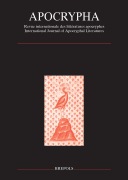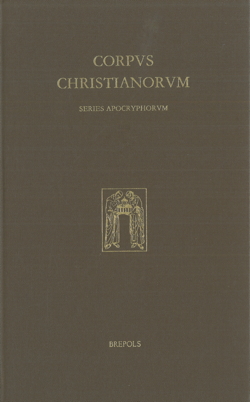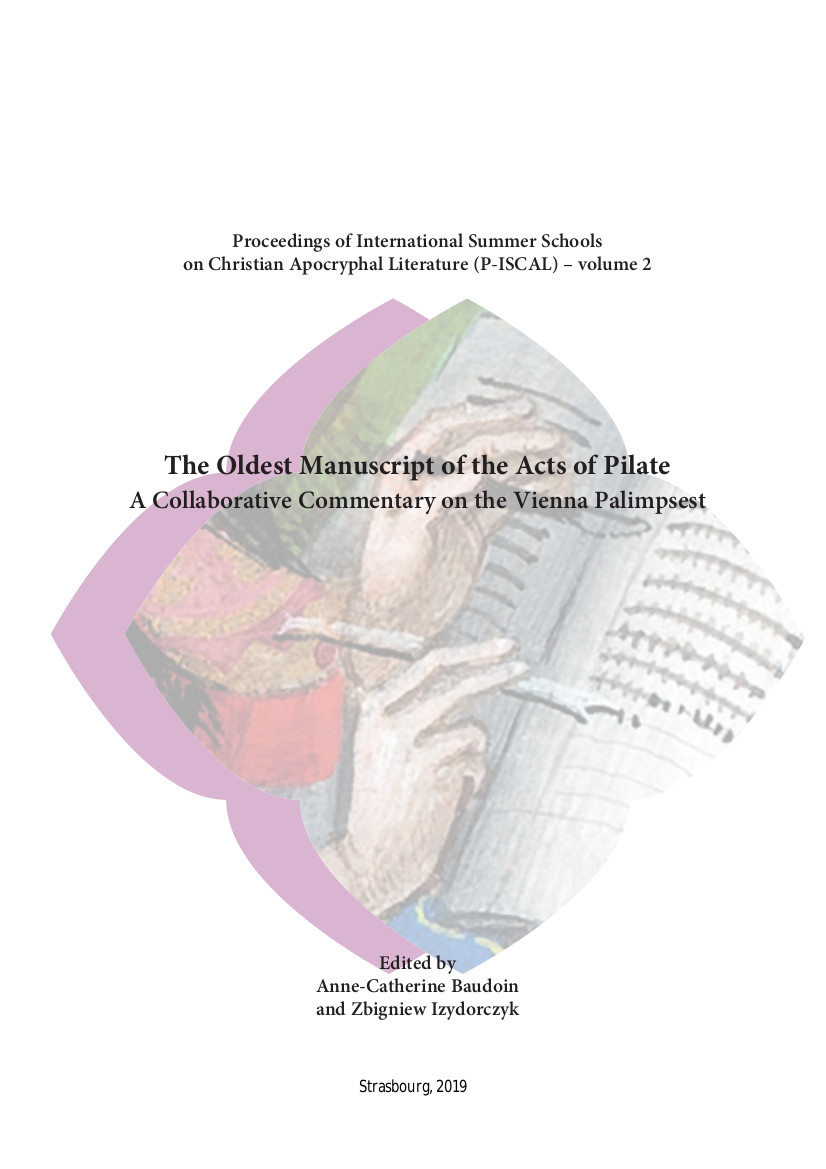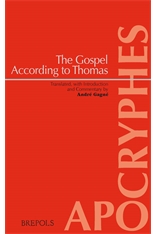Le volume 28 de la revue Apocrypha vient de paraître. Vous trouverez ci-dessous le résumé des articles.
Sommaire
« The Acts of Andrew and Philemon in Sahidic Coptic », par Ivan Miroshnikov, p. 9-83
This article provides an edition of the Sahidic Coptic Acts of Andrew and Philemon. In the introduction, the author surveys all known witnesses to the text of these acts, establishes the identity of their protagonist Philemon, and discusses the date and compositional history of the apocryphon. The author argues that there are two recensions of the text, a long and a short one, that the initial composition of the apocryphon should be assigned to either the fifth or the sixth century ce, and that the last of these acts is a later addition to the original text. The introduction is followed by the edition of all extant witnesses to the Coptic text. The article concludes with the English translation of all edited manuscripts, presented synoptically and accompanied by a commentary.
Le présent article fournit l’édition des Actes d’André et de Philémon en copte sahidique. Dans l’introduction, l’auteur passe en revue tous les témoins connus du texte de ces Actes, établit l’identité de leur protagoniste Philémon, puis discute la date et l’histoire de la composition de cet apocryphe. L’auteur démontre l’existence de deux recensions du texte, l’une longue et l’autre brève. Il estime que la composition de cet écrit doit remonter soit au ve soit au vie siècle et que le dernier des Actes est une addition ultérieure au texte original. L’introduction est suivie de l’édition intégrale de tous les témoins du texte copte. L’article se termine par une traduction anglaise synoptique de tous les manuscrits édités et des notes de commentaire.
« Joseph d’Arimathie, premier témoin du Ressuscité, protobaptisé, nouveau Noé : Étude des chapitres 12 à 16 des Actes de Pilate », par Anne-Catherine Baudouin, p. 85-122
Les chapitres 12 à 16 des Actes de Pilate forment un ensemble cohérent organisé autour de la figure de Joseph d’Arimathie, emprisonné par les juifs et libéré miraculeusement par Jésus ressuscité. Cette « histoire de Joseph d’Arimathie », attestée dans d’autres textes anciens, est quasi autonome par rapport à la première partie de l’œuvre. Elle est racontée d’abord du point de vue des juifs puis enrichie par trois discours de témoins : les gardes qui rapportent la résurrection, les trois rabbins qui attestent l’ascension, et Joseph lui-même qui fait le récit de sa libération de prison. Les indications de temps présentes dans les manuscrits grecs comme dans les différentes versions des Actes de Pilate montrent une chronologie chaotique des événements : malgré leur abondance, il est difficile de situer relativement l’emprisonnement de Joseph, sa libération et la résurrection ; cette confusion peut être la trace de débats anciens sur le moment de la résurrection, comme l’est l’importance particulière conférée à Joseph, présenté comme le premier témoin de Jésus ressuscité. Dans son discours final, Joseph raconte sa rencontre avec Jésus à la manière d’une scène de baptême dans laquelle, nouveau Noé, il est le juste et le premier bénéficiaire de la Nouvelle alliance.
Chapters 12 to 16 of the Acts of Pilate form a coherent textual entity organised around the figure of Joseph of Arimathea, who is imprisoned by the Jews and miraculously liberated by the resurrected Jesus. This “story of Joseph of Arimathea”, attested also in other ancient texts, is almost independent of the first part of the apocryphal work. It is presented, initially, from the point of view of the Jews, but later elaborated through three eye-witness accounts : by the guards who report on the resurrection, by the three rabbis who testify to the ascension, and by Joseph himself, who relates his release from prison. The indications of time given in the Greek manuscripts as well as in the Eastern and Latin versions project an inconsistent chronology of events : although numerous, they do not allow to establish unambiguous temporal relationships among Joseph’s imprisonment, Jesus’ resurrection, and Joseph’s liberation. This chronological incoherence may be as much an echo of ancient arguments about the exact moment of the resurrection, as it is evidence of the special place given to Joseph as the first witness of the risen Jesus. In his final speech, Joseph narrates his encounter with Jesus as a baptismal scene in which he, like a second Noah, is the righteous one and the first beneficiary of the New Covenant.
« Rebranding Iphigenia as Christian: Virgins in Ambrose’s De Virginibus and in the Apocryphal Passio Matthaei », par Anna Lefteratour, p. 123-154
Cet article explorera deux cas de réception de l’Iphigénie d’Euripide dans l’antiquité tardive à travers les adaptations romanesques d’Achilles Tatius et d’Héliodore. Le premier texte est le De Virginibus d’Ambroise écrit à Milan en 374, et le deuxième est la légende du martyre de Matthieu en Éthiopie, le Passio Matthaei, dont la date de composition pourrait remonter au vie siècle ap. J-C. Je tenterai ici d’entrer dans le monde du lecteur occidental entre le ive et le vie siècle. J’examinerai comment des récits chrétiens anciens et des romans hellénistiques ont influencé la forme du mythe d’Iphigénie dans l’Antiquité tardive et comment les mythes classiques ont été reconfigurés et récrits à l’intention d’un public chrétien.
This paper sets to investigate two cases of a late antique reception of the Euripidean Iphigenia through the novelistic adaptations of her story by Achilles Tatius and of Heliodorus. The first test case is Ambrose’s treatise De Virginibus written in Milan in 374, and the second the legend of St. Matthew’s martyrdom in Ethiopia, the Passio Matthaei, dated in the sixth century ce. My aim is to focus on the background of the readers of the fourth and the sixth century in the West. In the paper, I examine how early Christian narratives and the Greek novels influenced the late antique version of the Iphigenia myth and how classical myths were rebranded and rewritten for their late antique Christian audiences.
« A Welsh Version of Visio Pauli: Its Latin Source and the Translator’s Contribution », par Elena Parina, p. 155-186
This article undertakes a comparative analysis of the Middle Welsh version of Visio Pauli transmitted in Oxford Jesus College MS. 119 in relation to its Latin analogues. According to Silverstein’s stemmatic approach, the Latin text behind the Welsh translation belonged to Group D in Dwyer?s more recent classification ; it shows many characteristics of this group, but also lacks some significant markers. Following Jiroušková?s alternative classification, the underlying Latin text as it can be reconstructed on the basis of the Welsh version, belongs to her C-group and has some features of the C3 group, but more parallels to C1 texts. On the basis of a number of features shared by all Welsh versions and a small group of Latin texts in manuscripts C5/L7/L8 (belonging to C1 and D respectively), there are good reasons to argue that the original of the Welsh text was fairly close to them. The results of the comparison also allow to identify changes that the Latin text underwent in the course of the translation, with the caveat that the immediate source of the translation is not available. The most important changes are additions of formulae that can be explained as stylistic devices and some adaptions of content for the sake of the new Welsh audience.
Cet article consiste en une analyse comparative de la version de la Visio Pauli transmise en moyen gallois dans le manuscrit d’Oxford Jesus College MS. 119 avec des versions latines. D’après l’approche stemmatique de Silverstein, le texte latin qui est derrière la traduction galloise appartient au groupe D de la classification plus récente de Dwyer ; il partage de nombreuses caractéristiques de ce groupe, mais quelques-unes qui sont importantes manquent aussi. Si on se fonde sur la classification alternative que propose Jiroušková, le texte latin, tel que l’on peut le reconstruire à partir de la version galloise, appartient au groupe C de Jiroušková ; il partage quelques caractéristiques avec le groupe C3 mais comporte plus d’éléments en commun avec les textes du groupe C1. Sur la base d’un certain nombre de points communs à toutes les versions galloises et à un petit groupe de textes latins dans les manuscrits C5/L7/L8 (qui appartiennent respectivement aux groupes C1 et D), il y a de bonnes raisons de penser que le texte gallois en est proche. Les résultats de la comparaison permettent aussi d’identifier les changements que le texte latin a subis durant la traduction, avec le caveat que la source immédiate de la traduction n’est pas disponible. Les modifications opérées par le traducteur lui permettent d’adapter soit le style au gallois soit le contenu au nouvel auditoire gallois.
« Réception et fonctions des récits apocryphes dans la Josephina de Jean Gerson », par Isabel Iribarren, p. 187-229
Cet article examine la réception des récits apocryphes dans l’œuvre de Jean Gerson (1368-1429), chancelier de l’Université de Paris, en particulier dans son poème épique Josephina, composée entre 1414 et 1417 au concile de Constance. Moins réceptif des éléments apocryphes que les compilateurs dominicains ou que ses devanciers dans la tradition de littérature dévotionnelle tardo-médiévale, le verdict de Gerson concernant la valeur des apocryphes reste équivoque. D’une part, il se hâte de condamner certains traits apocryphes qu’il considère dangereux ou au mieux désuets, lorsqu’ils ne conviennent pas à son agenda doctrinal (notamment à propos de l’âge de Joseph et de son rôle dans l’Histoire du salut) ; d’autre part, Gerson accueille volontiers des sources extra-scripturaires, en l’occurrence le Pseudo-Matthieu et le Libellus de Nativitate Mariae, lorsqu’il s’agit de l’enfance de Marie et de son éducation. Après une analyse de la notion de « vérité probable », noyau de l’ars poetica gersonienne gouvernant sa reconstruction du récit biblique, l’article débouche sur la question du statut de l’épopée en tant que construction littéraire. La Josephina peut-elle être considérée comme un récit apocryphe, compte tenu de ses mécanismes narratifs et de ses objectifs doctrinaux ?
The article examines the reception of apocryphal narratives in the work of Jean Gerson (1368-1429), chancelor of Paris University, in particular in his epic poem Josephina, composed between 1414 and 1417 at the Council of Constance. Less receptive of apocryphal elements than thirteenth-century Dominican compilators or other authors of late-medieval devotional literature, Gerson’s verdict on the value of apocrypha remains equivocal. On the one hand, he is keen on condemning certain apocryphal features that he considers dangerous or at best obsolete, when they do not suit his doctrinal agenda (notably concerning Joseph’s age and his role in the History of Salvation) ; on the other hand, Gerson shows to be quite receptive of extra-canonical sources, especially the Pseudo-Matthew and the Libellus de Nativitate Mariae, regarding Mary’s early life and education at the Temple. After analysing the notion of “probable truth” central to Gerson’s ars poetica and governing his reconstruction of the Biblical narrative, the article ends with the question of the poem’s literary status : in its literary mechanisms and doctrinal objectives, should the Josephina count as an apocryphal narrative ?
« Notes on the History of Joseph (CAVT 113, 114) and the Death of Joseph (CAVT 116, 117) », par Aaron Michael Butts, Kristian Heal, Geoffrey Moseley, Joseph Witztum, p. 233-237
« New Testament Apocrypha: More Noncanonical Scriptures », par Gavin McDowell, p. 241-252
Étude critique (en anglais).
Recensions
, p. 253-290



